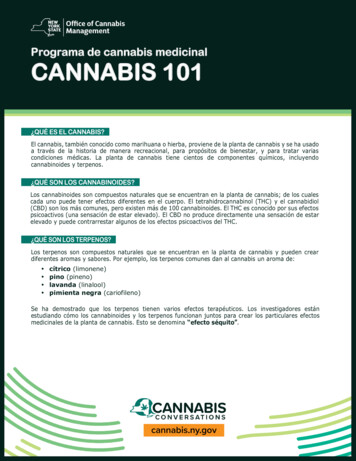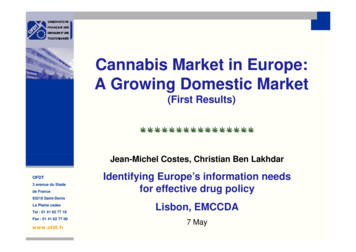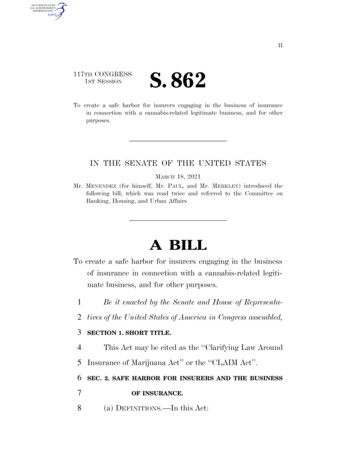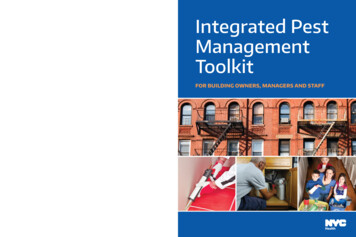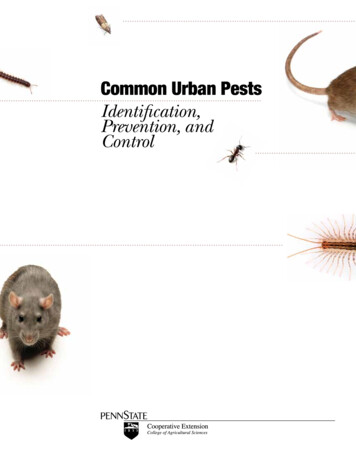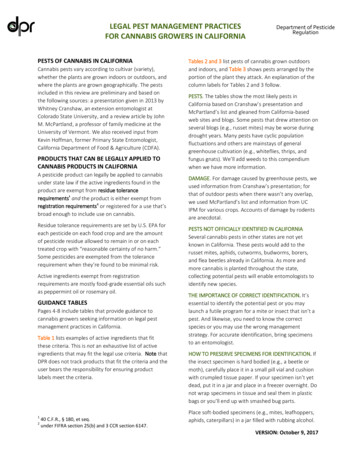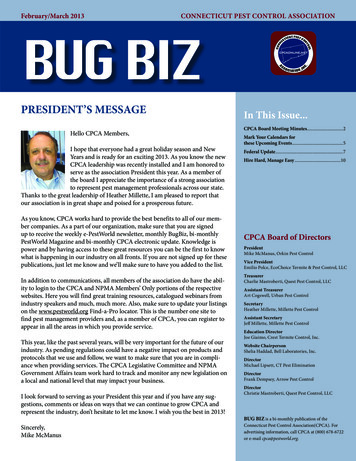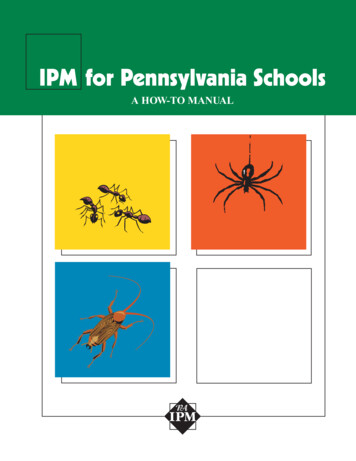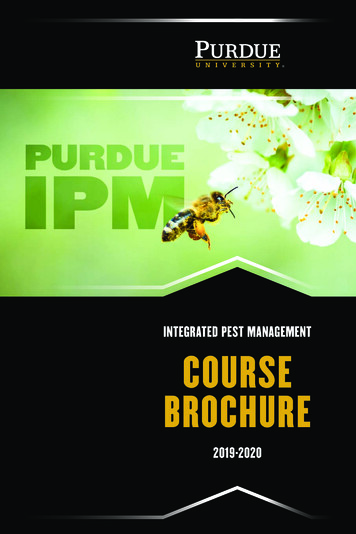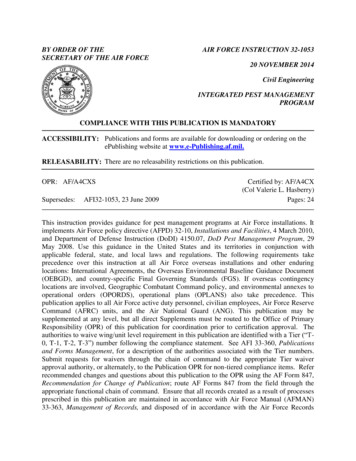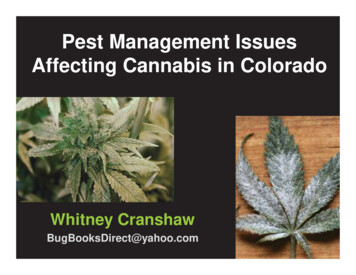
Transcription
Pest Management IssuesAffecting Cannabis in ColoradoWhitney CranshawBugBooksDirect@yahoo.com
Primary Pest Problems of Observedwith Indoor Grown Cannabis Abiotic disorders (e.g., nutrition) Pathogens– Powdery mildew– Pythium root rots Arthropods– Twospotted spider mite– Hemp russet mite– Rice root aphid– Fungus gnats
Pythium root rotsPythium spp.
Twospotted spidermiteTetranychus urticae
Powdery mildewof CannabisPodosphaera macularis
Photo credit Karl HilligHemp russet miteAculops cannabicola
Rice root aphidRhopalosiphum abdominalis
Darkwinged fungusgnatsBradysia spp.
Federal Laws and Pesticides Marijuana is classified as Schedule IControlled Substance– As a result no federal agency will recognize thecrop for any purpose – other than drug lawenforcement EPA will not establish a crop category forcannabis under pesticide laws– EPA regulates the use of pesticides underprovisions of law defined by FIFRA– No pesticides can be used legally on a crop ifthe use is not allowed for that crop category
Phases of Pesticide Use Regulationin Cannabis Production Phase I - “Wild West” Phase Phase II - State Finesse Phase Phase III - Normalization Phase–Cannabis is federally recognizedas a crop–Cannabis is regulated as anormal crop
“Wild West Phase” All registered pesticides are illegal Pesticide laws are completely ignored Pesticide regulation and enforcement isignored by state and federal agencies All pest management informationsources devolve to the internet andhearsay
Spider Mite Management on the Internet“ .Consider this situation, you spray yourchemicals, the mites may not die right awaydepending on the mode of action, whathappens next is the mites panic and startlaying eggs like crazy. Before you know it,the mites have become twice as bad asbefore you hit them ”Information from Legal Hydro web site
Spider Mite Management on the Internet“ .The best method to control this pest isto switch your mode of attack each andevery day. Never spray them with the samestuff twice in a row, if you choose thechemical approach, you want to use aNeem Oil along with as many other forms ofMiticides as you can get your hands on ”Information from Legal Hydro web site
August 14 Letter from a Cannabis ProducerChecklist of treatments July 18-August 12 BioWar (unspecified “beneficial soil microbes) Sulfur/pyrethrins
August 14 Letter 2013 from a CannabisProducerChecklist of treatments July 18-August 12 BioWar (unspecified “beneficial soil microbes)Sulfur/pyrethrinsAbamectin (Avid)Chlorfenapyr (Pylon)Abamectin/binfenzate (Scirocco)Fenpyroximate (Akari)AbamectinFenazaquin (Magister)
Present Status of Pesticide for Use on theCrop: Any pesticide that is a registeredpesticide is illegal to use on Cannabis underfederal law
Pesticide Use On CannabisPesticides that are illegal because ofregulatory indecisionAzadirachtinMicrobial controlsHorticulturaloilsPyrethrins
Pesticide Use on CannabisPesticides that are illegal because theyhave not been tested on nor registeredfor any crops similar to cannabisFenpyroximateBifenazateAbamectin
“State Finesse Phase” Some pesticides are identified by Stateagencies as allowable in Cannabisproduction Uneasy alliance with Federal agenciesas Cannabis remains unrecognized ascrop Pest management information sourcesare provided minimal support by stateand local agencies
2013 Washington State Finesse on theSubject of Pesticide Use on Cannabis Pesticides that require federalregistration under Section 3 of FIFRA– Active ingredient is exempt from therequirements of food crop tolerance, and– Label has directions for use onunspecified food crops, includingunspecified food crops grown as beddingplants– EPA and WSDA registration is required Section 25b minimum risk pesticides(exempt from federal registration)
Products allowed with WDAFinesse AzadirachtinBacillus pumilusBacillus subtilisBacillus thuringiensisCanola oilChromobacteriumGliocladium virensHydrogen peroxide Mineral oilsNeem oilPhosphorous acidPotassiumbicarbonateInsecticidal soapsPyrethrinsStreptomyces spp.Trichoderma spp.
Criteria for April 2015 ColoradoDepartment of Agriculture Listing ofAllowable Pesticides on CannabisxxxThe label allows for use on unspecifiedcrops and/or plants, and;The label allows use at the intendedsite of application, and;The label directions do not prohibit useon crops or plants intended for humanconsumption.
Products Listed as Allowable by theCDA on Cannabis Grown in Colorado Azadirachtin (some) Insecticidal soaps(some) Horticultural oils– Mineral– Seed/Vegetable Various essentialoils Pyrethrins (some) Phosphorous acid Potassiumbicarbonate (some) Many microbesused for biologicalcontrol– Some fungi– Some bacteria
A step to normalization? EPA does indicate itwould consider Special Local Needsregistrations for Cannabis (May 19)
General Thoughts on Pest ManagementApproaches for Key Pests
Powdery mildewof CannabisPodosphaera( Sphaerotheca)macularisSusceptible crops tothis species ofpowdery mildewfungus include: hops,strawberry,delphinium, phlox,potentilla, geranium
Some IPM Tools forPowdery Mildew Exclusion of causal organism Oils, desiccants to kill stageson leaf surfaces Biological control agents Improved air circulation
Powdery Mildew Treatments Oils–Petroleum/Paraffinic–Neem Biological Controls Potassium bicarbonate
Horticultural Oils Primarily act by smotheringinsects Derived from various sources– Petroleum/Mineral oils– Vegetable oils (cottonseed, soybean)– Neem seed extracts– Fish oils
Examples of a highlyrefined petroleum oils(mineral oils) that haslabeling for use onherbs and spices –and ColoradoCannabis
Neem oil products (clarified hydrophobic extracts ofneem seed oil)Note: In theseproducts theazadirachtin hasbeen removed
Streptomyces lydicus WYEC108 StrainMicrobial BioControlsfor Powdery MildewBacillus amyloliquifaciensStrain D747Bacillus subtilis QST713 Strain
PotassiumBicarbonateProducts
Potassium bicarbonate product –Presently CDA allowable, butonly for home usesPotassium bicarbonate product– Not presently CDA allowable.Candidate for Special LocalNeed registration?
SulfurOnly sulfurproductpresently onCDA AllowableList.Not allowed incommercialproduction.
Pythiumroot rots
The life cycle of Pythiumincludes a stage(oospores) designed tosurvive for long periodsand is very difficult to kill.Pythium oospores in Cannabis root
Rooting areas, oncecolonized by Pythium,can easily become acontinuous source ofnew infections
Zoospores can easilyspread through ahydroponic system
Some IPM Tools forPythium Root Rots Start with clean plants Avoid practices that allow spores tospread between plants Incorporate effective biological controlagents into root growing media and/orseedling starts
Disinfesting Pythium Do not reuse infested equipmentDisinfestation with oxidizing agentsHeat/pressure disinfestation/AutoclaveOzone sterilization?Ultraviolet sterilization?
Key point inproduction – rootingareas must be keptclean of Pythium
Hydrogenperoxide productsThe only oxidizer-typepesticide that ispresently allowed foruse on Cannabis
Lowering pH increase OxidationReduction Potential – which increasesmortality of Pythium
Phosphorous AcidFungicide Act by stimulatingsystemic acquiredresistance response Primarily active against“water mold” types of fungi
Potential Biological Control Agents forPythium Phosphorous acid products Various Trichoderma species fungi– Strains of T. gamesii, T. hamatum, T.harzianum, T. virens; Gliocladium virens Streptomyces lydicus Bacillus pumilus
Trichoderma harzianum(RootShield)Trichoderma harzianumand Trichoderma virens(Rootshield Plus)Antagonistic to some soil fungi(competition, antibiosis)Used as a preventive treatment
Trichoderma hamatumisolate 382InceptStreptomyces lydicusWYEC 108 StrainActinovate
Biological controlfungi are best used inearly seedling stages –they must colonize theroot surface ahead ofthe pathogen for besteffect
Mites
Twospotted spidermiteTetranychus urticae
Note: Cannabis is the onlyknown host for the hemprusset mite
Spider Mite Management Prevent introduction of mitesinto growing facility Start with clean plants Move plants through productionways that prevent crosscontamination Oils can be used as sprays Biological controls?
Constantly monitor plants for signs of spider mitepresence/activityCatch early signssuch as this
before it progressesto this .
and way beforethis.
Cuttings, if used, mustbe disinfested of allliving stages of mitesbefore introductioninto a growing area
Avoid conditions that allow “steamrolliing” ofmite populations
Sprays with some activityagainst spider mites Horticultural oils–Petroleum/Paraffinic–Neem Insecticidal soap? Essential oils?
Examples of mineral/petroleum/paraffinic oils* that areallowable in Colorado*Typically used at 2%concentration of active ingredient
Some neem oil products* (clarified hydrophobicextracts of neem seed oil) allowable for use inColorado* Typically used at 2%concentration of activeingredient
Essential Oil Products? Derived from a wide variety of plants– Rosemary, thyme, garlic, geraniol,cedar . Most are exempt from pesticideregistration requirements Phytotoxicity potential with some Most have very little testing tosupport claims of effectivenessunder Cannabis growing conditions
Essential OilProducts?
Predatory Mites for Use onCannabis? Mesoseiulus longipes Neoseiulus californicus Galendromus occidentalisNote: The above species are the predatory mites that aremost tolerant of low humidity. However, performance ofall is reduced under low humidity.
Predatory Mite: Galendromus occidentalisOptimal environmental conditions80-100 degrees F 50% RH
Predatory Mite: Mesoseiulus longipesCan only tolerate the very low humidity of 40%when the temperature is 70 F.Requires increasing humidity astemperature rises.
UH WKHUH VSLGHU PLWH UHVLVWDQW &DQQDELV FXOWLYDUV""" Plants that do not support spidermites (Antibiosis)Plants that do not sustain lossfrom spider mite injury(Tolerance)
Pest Management Issues AffectingGreenhouse Grown Cannabis inColoradoWhitney CranshawBugBooksDirect@yahoo.com
Essential oils? Examples of mineral/petroleum/ paraffinic oils* that are allowable in Colorado *Typically used at 2% concentration of active ingredient. Some neem oil products* (clarified hydrophobic extracts of neem seed oil) allowable for use in Colorado * Typically used at 2%
